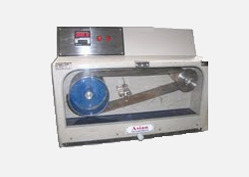Belt Flex Tester

Out soles of footwear or other flexing components may suffer cracking in use due to flexing. Cracks usually develop at points of high surface strain resulting from the design of the sole pattern, without there being any cuts to initiates them. The Belt Flex Tester is designed to flex complete soles with their patterns intact in a manner similar to those encountered in actual use. Tests carried out using it provide a guide to the risk of such cracks developing during use.
The test specimens are attached to the outside of a continuous belt, which is driven round two rollers. The large roller drives the belt while movement of the smaller roller is chosen to make the flexing somewhat more severe than is actual use. This form of flexing also closely simulates the actual bending at each step as it produces a short period of rapid flexing followed by a longer period when the specimen is not being flexed.
A normal test consists of a number of flexing runs up to a total of 50,000 flexes, with an examination for cracking at the end of each run.
The Belt Flex Tester consists of two roller on which a flat belt moves. The larger roller which is the driving roller rotates at a specified speed to give the specified frequency of flexing with the help of an electric motor and V belt arrangement. The second roller, which is the flexing roller, rotates with the movement of the belt.
The flexing rollers are slightly barrel shaped so as to minimize sideways movement of the belt. A hand wheel is attached to the front end of these rollers to enable the belt to be moved by hand. The equipment is supplied with three flexing rollers, one for normal soles, the second for very flexible soles, and the third for very rigid soles.
The distance between the driving and the flexing rollers can adjusted with the help of a screw arrangement to enable the belt to be mounted over different flexing rollers and to allow for small differences in belt length. This is done by turning a hand wheel on the side of the tester.
The tester is fitted with an acrylic front cover and a wire mesh safety guard, which allows adequate circulation of cooling air round the test specimens during the test. For safety of the user, the motor can be started only when cover is closed.
